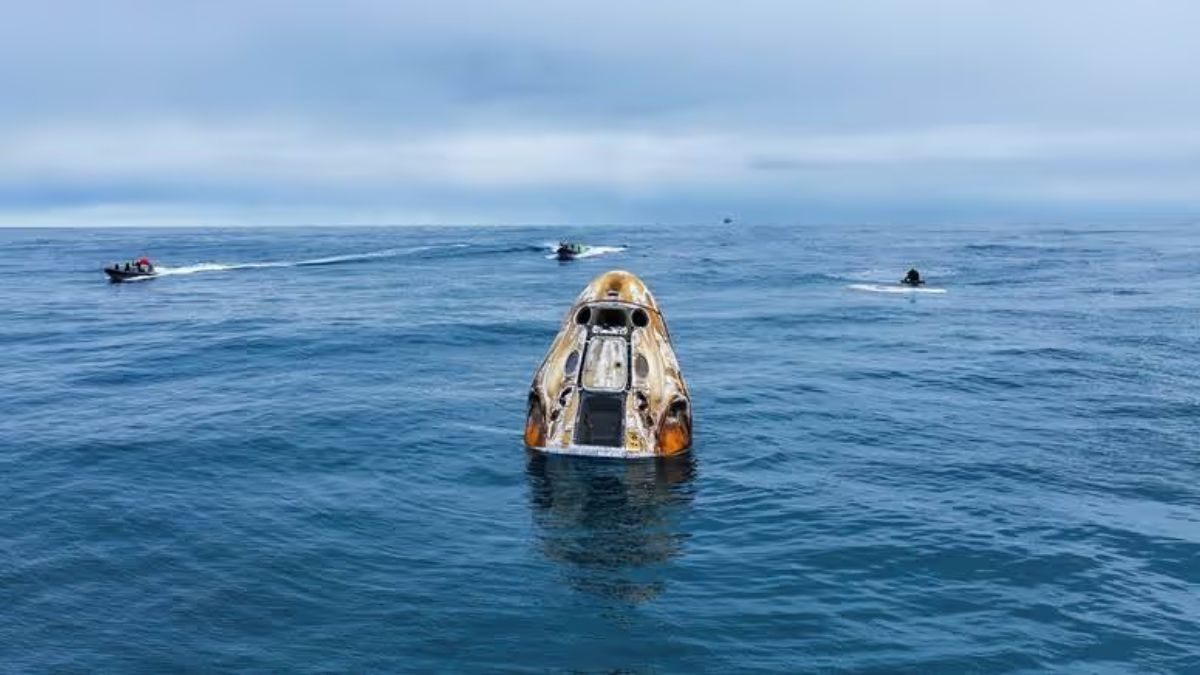The 22-hour journey home: Here is why the SpaceX Dragon takes nearly a day to return from space
 From the Axiom Mission 3: SpaceX Dragon spacecraft carrying the Ax-3 crew splashed down off the coast of Daytona, Florida on February 9 2024 [File] | Axiom Space
From the Axiom Mission 3: SpaceX Dragon spacecraft carrying the Ax-3 crew splashed down off the coast of Daytona, Florida on February 9 2024 [File] | Axiom Space
When the Axiom Mission 4 (Ax-4) crew undocks from the International Space Station (ISS) on Monday at 4.35 pm, they won’t splash down in the ocean until Tuesday at 3.00 pm—nearly 22 hours later, concluding nearly 18 days spent in orbit. To those watching from Earth, this might seem puzzling. After all, the space station orbits just 400 kilometres above us, and modern rockets can reach space in minutes. So why does it take almost a full day for astronauts to come home?
The answer lies in the complex dance of orbital mechanics and safety protocols that govern every aspect of human spaceflight. Unlike a simple trip down from a tall building, returning from orbit isn’t about dropping straight down—it’s about precisely timing your arrival at a specific patch of ocean while travelling at 28,000 kilometres per hour around a rotating planet.
The journey begins with departure burns that safely move Dragon away from the ISS into a slightly different orbit. “This isn’t just a courtesy, it’s a critical safety measure to ensure the capsule doesn’t accidentally collide with the station. The spacecraft then enters what engineers call “free flight,” where it could theoretically stay in orbit for anywhere from six to 30 hours, depending on landing conditions on Earth,” explained space analyst Girish Linganna.
Here’s where Earth’s rotation becomes crucial. As Dragon orbits overhead, our planet spins beneath it, constantly changing which part of the ocean lies directly below the spacecraft’s path.
The capsule can only land in specific recovery zones off the coast of Florida, where weather conditions meet strict safety requirements. These zones must have winds below 16.5 kilometres per hour, wave slopes under seven degrees, less than a 25 per cent chance of rain, and no lightning within 16 kilometres.
The recovery ships positioned in these zones cannot have more than four degrees of pitch or roll—or helicopters cannot safely land on their decks.
Several hours before splashdown, Dragon performs what’s called a phasing burn—six minutes of small thruster firings that seem minor but are actually crucial.
At orbital speeds, even tiny velocity changes can shift the final landing point by hundreds of kilometres. This burn ensures Dragon passes over the recovery zone at precisely the right moment when weather conditions are acceptable.
“The real drama begins 52 minutes before splashdown with the deorbit burn. For 15 minutes, Dragon’s small Draco thrusters fire continuously, gradually slowing the spacecraft from orbital velocity. These aren’t powerful engines they’re designed for precision, not speed. Think of trying to stop a freight train with bicycle brakes—it works, but it takes time. This burn doesn’t stop Dragon completely; it just slows it enough to lower its orbit until it intersects with Earth’s thick atmosphere,” added Linganna.
After the deorbit burn, Dragon still needs time to coast to the atmospheric entry point, then fall through the atmosphere, getting heated to over 1,900 degrees Celsius due to air friction. The heat shield protects the crew during this fiery plunge, but the process cannot be rushed.
At about 5,500 metre altitude, drogue parachutes deploy, followed by the main parachutes, which bring the capsule down to its final touchdown speed of 23–27 kilometres per hour. Though this is still fast, the ocean cushions the impact, and the capsule is built to handle this kind of landing.
The moment Dragon hits the water, a carefully choreographed recovery operation begins. Fast boats race to reach the capsule while crews conduct hypergolic gas checks to ensure no toxic fuel vapours are in the air. They inspect the vehicle’s integrity, remove parachutes that could drag the capsule underwater, and prepare for crew extraction. The recovery ship must maintain stability within four degrees of pitch and roll to allow helicopters to safely land and transport medical personnel or evacuate astronauts who may need urgent attention after months in zero gravity.
This extended timeline isn’t inefficiency—it’s the result of decades of hard-learned lessons about bringing humans safely back from space. Every hour of that 22-hour journey serves a purpose: from ensuring the correct orbital alignment to allowing weather conditions to stabilise at the recovery site.
The Apollo astronauts who returned from the Moon faced similar lengthy journeys, and today’s commercial crews deal with the same core challenge: safely transitioning from the harsh environment of space to the safety of Earth’s oceans.
Sci/Tech